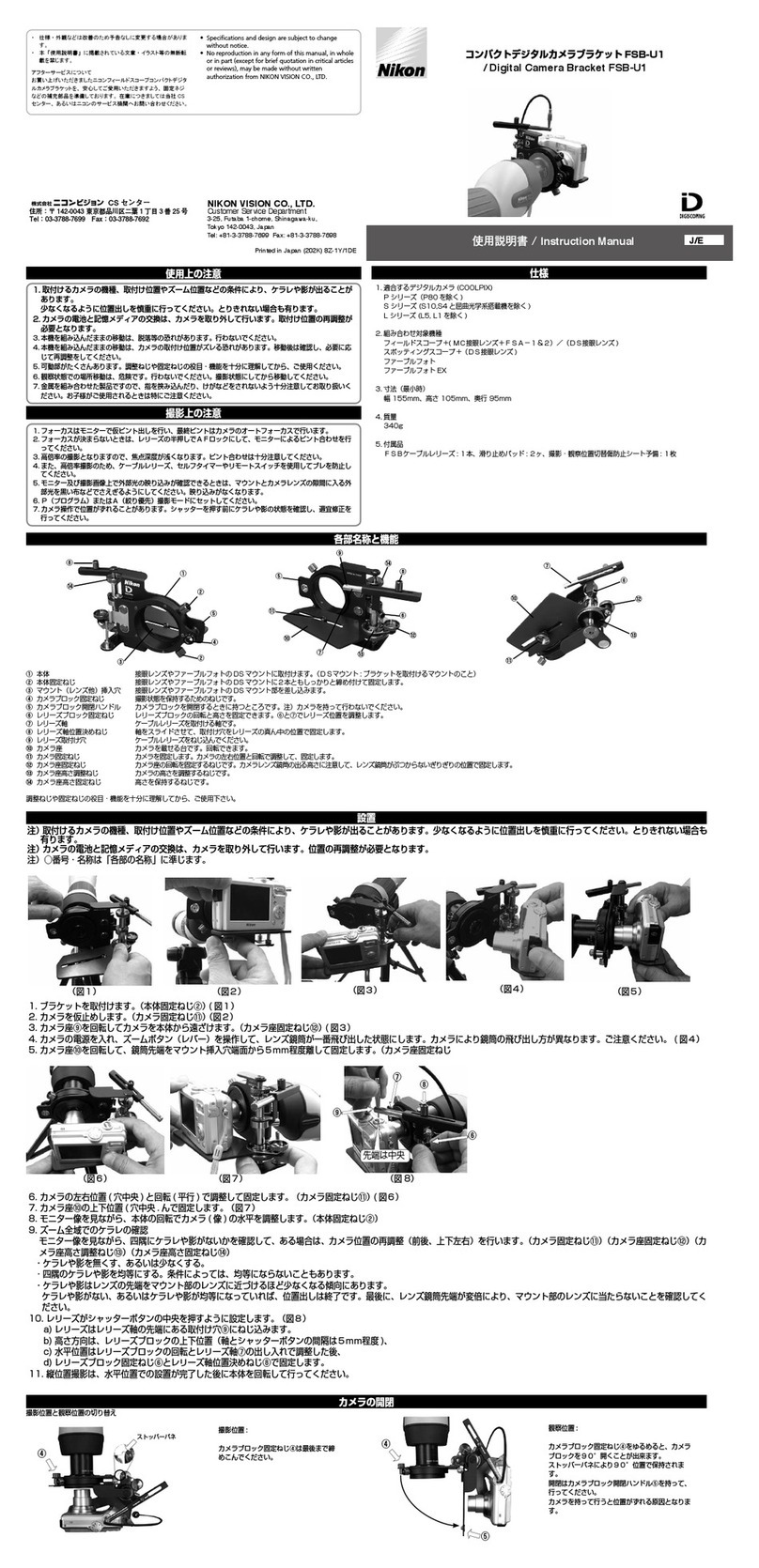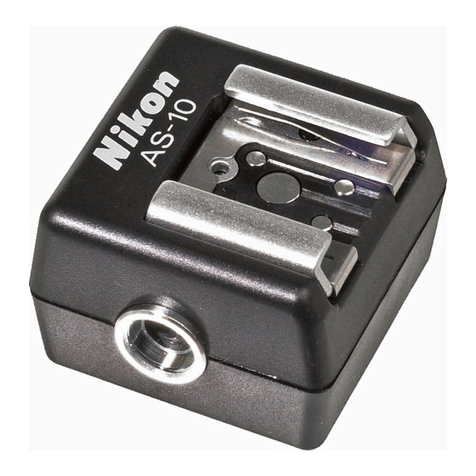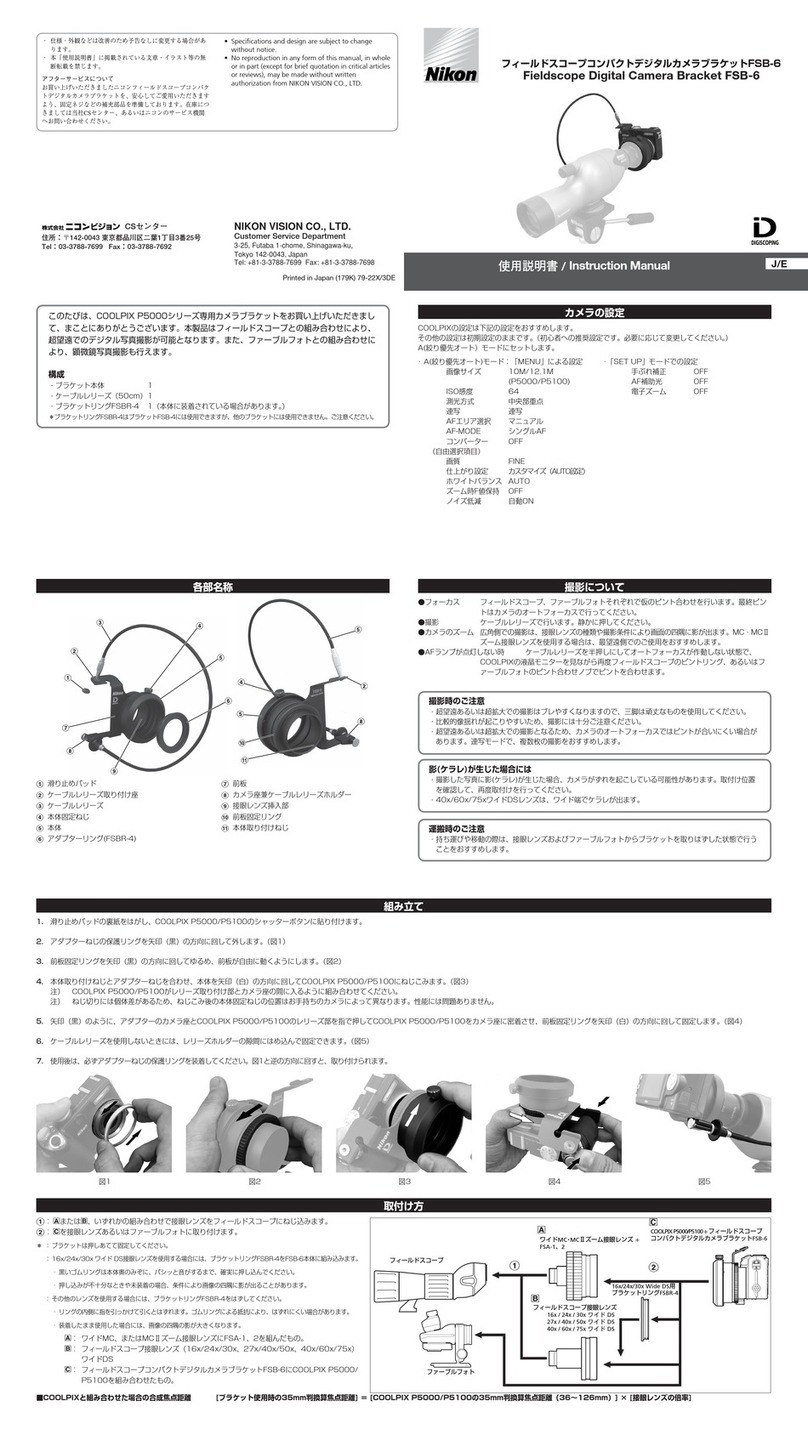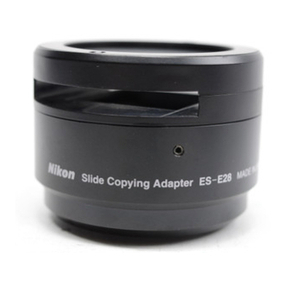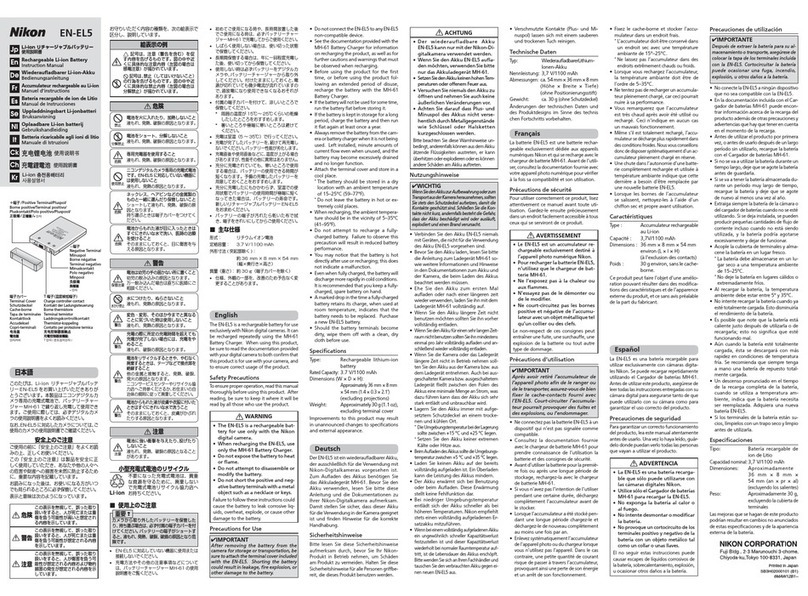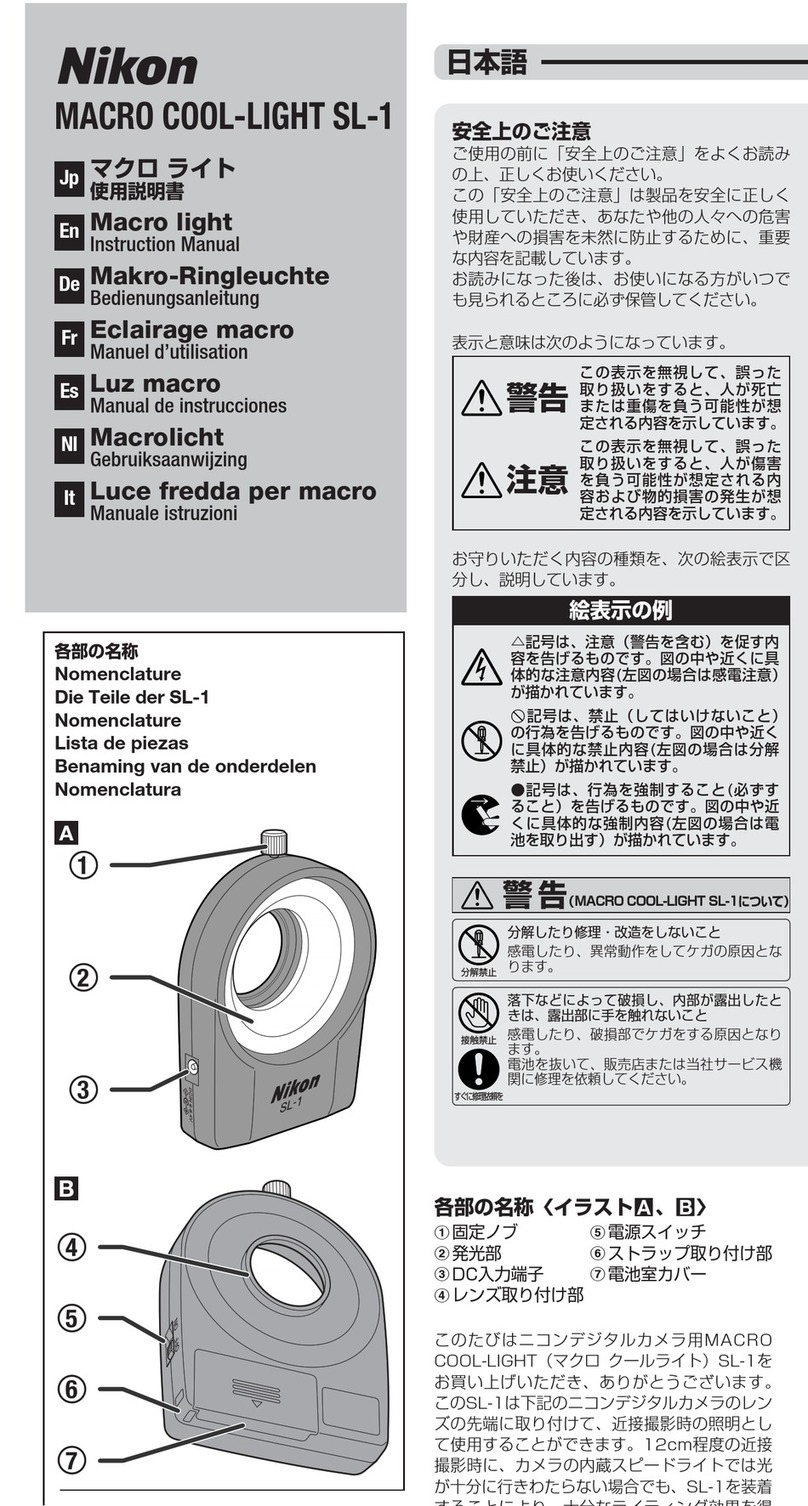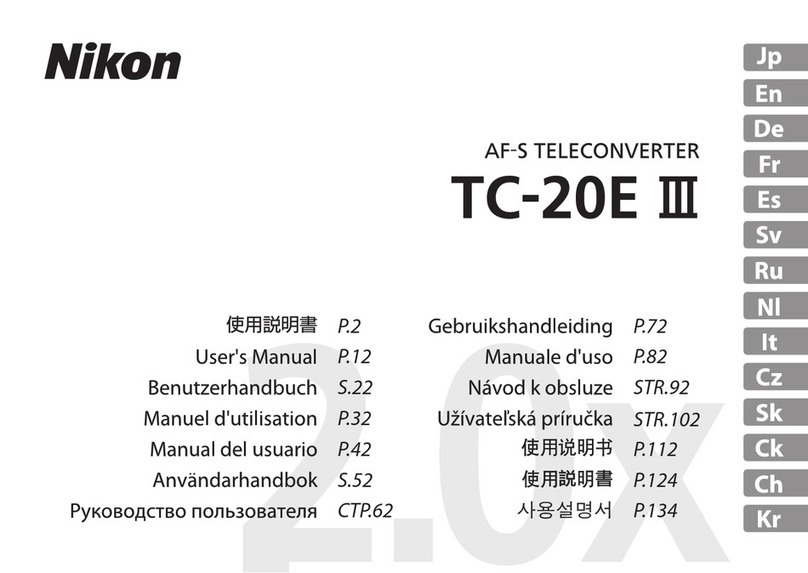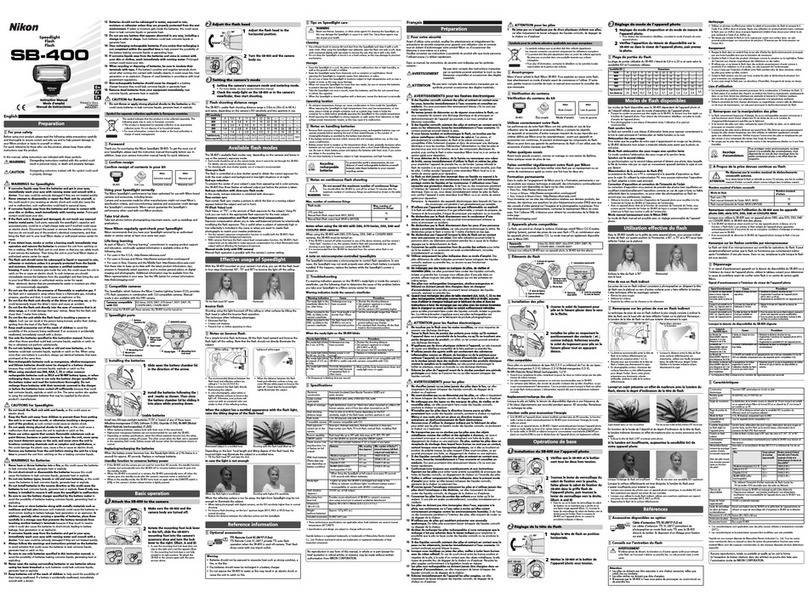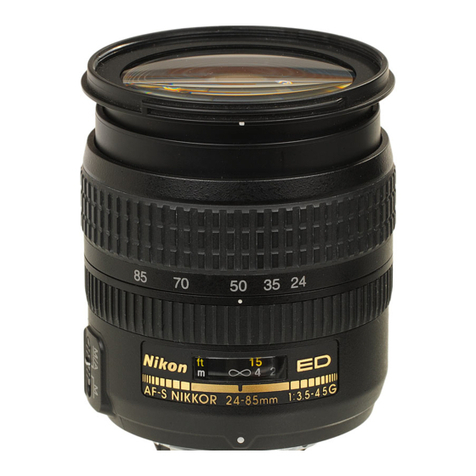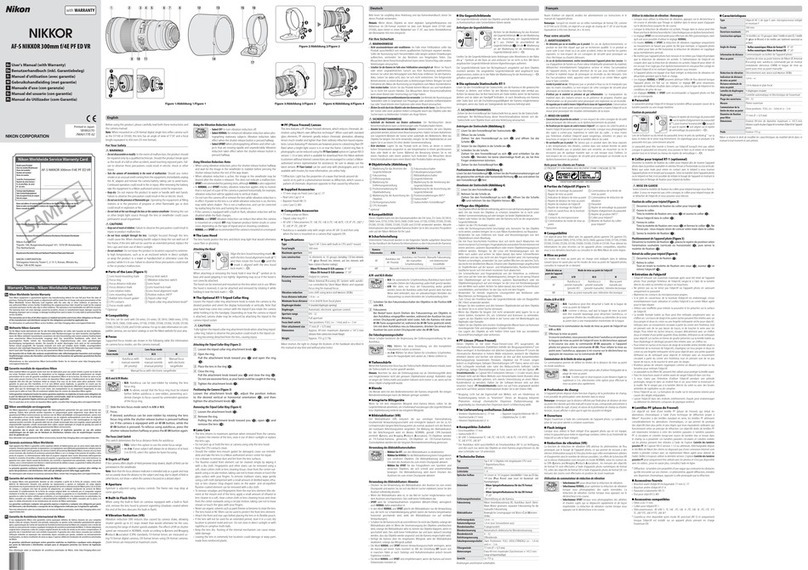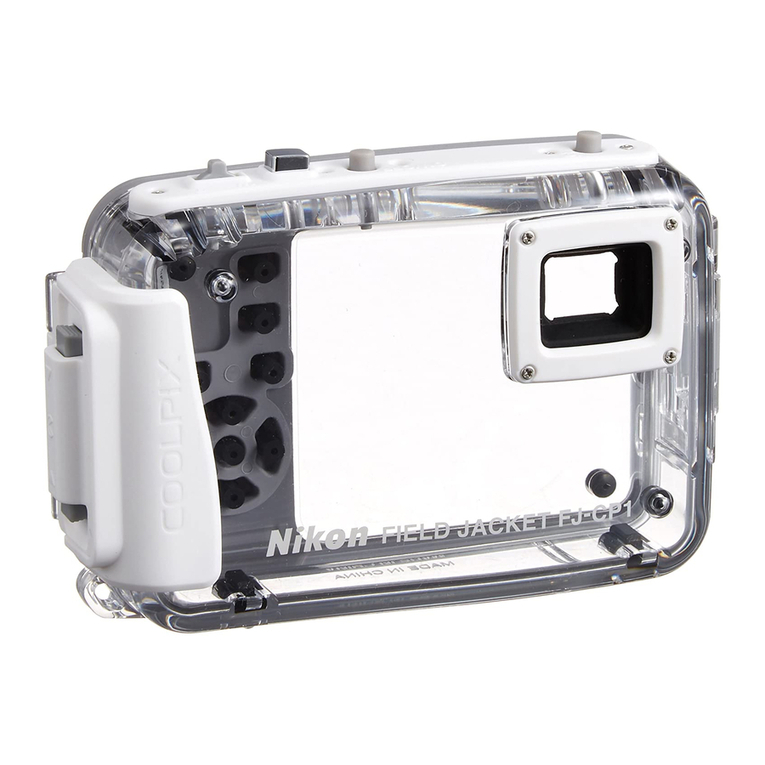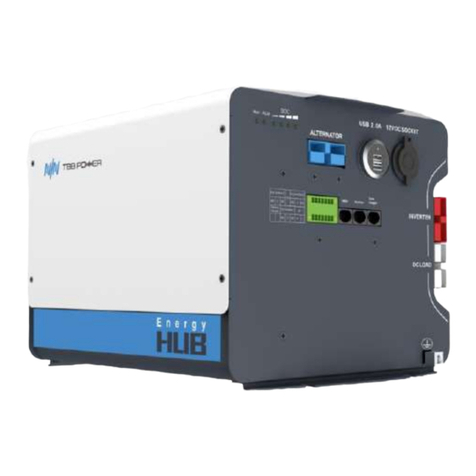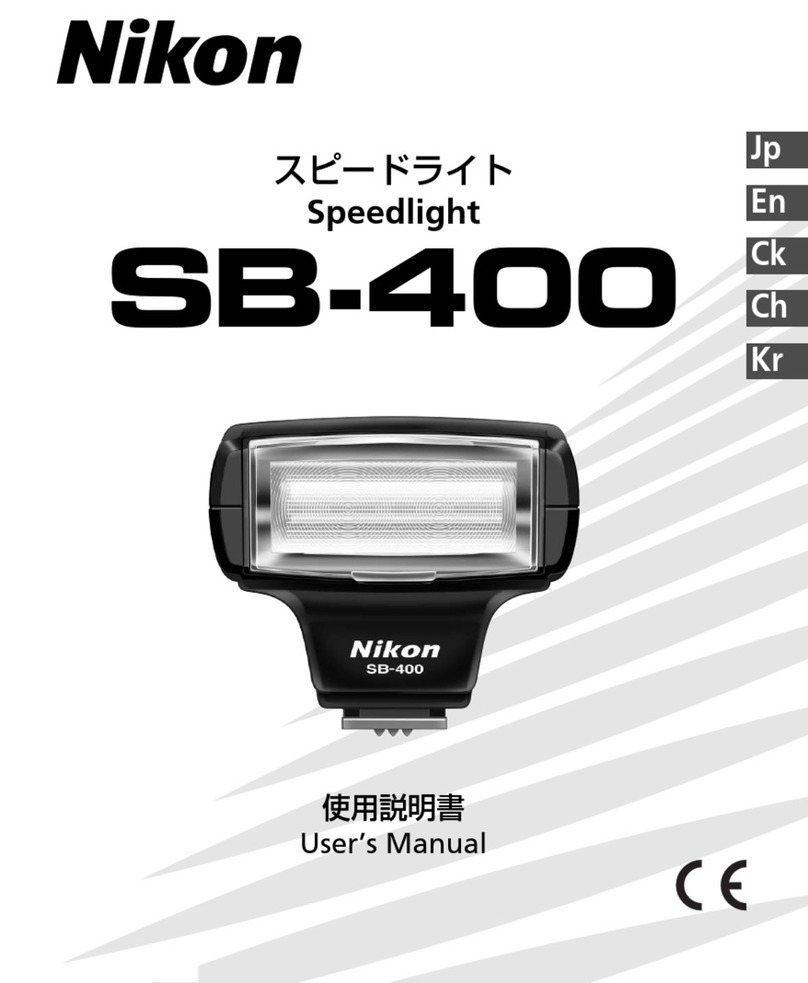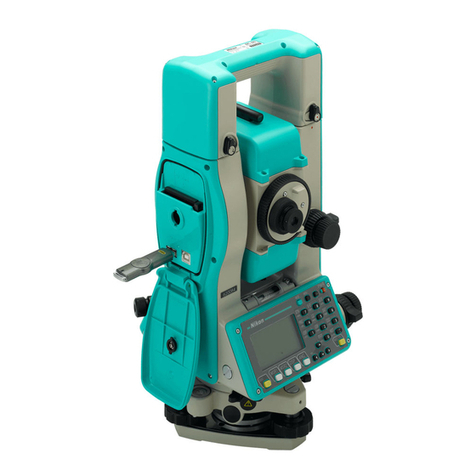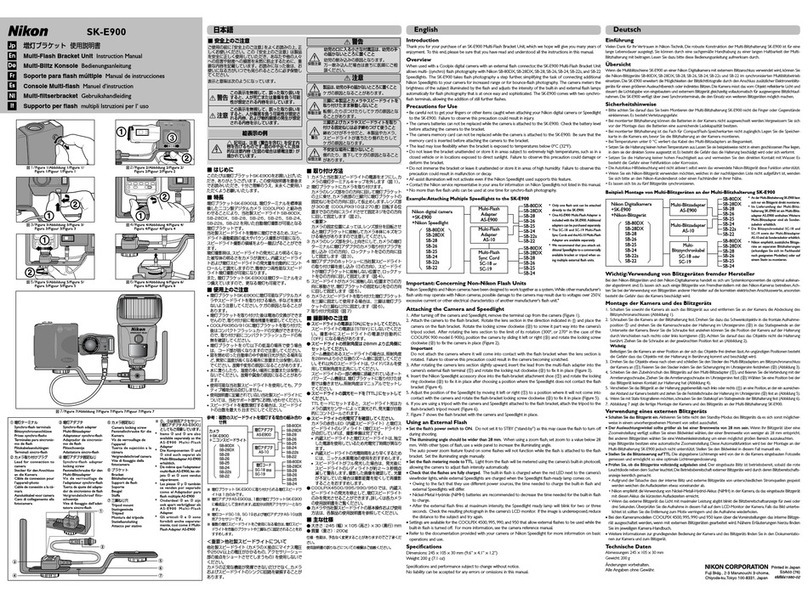
©1993 Nikon Corporation
English
Thank you for purchasing a Nikon product. The AF Micro-Nikkor
ED 200mm f/4D IF lens supplies distance information to the cam-
era body for instantaneous 3D matrix metering or 3D multi-sensor
balanced ll-ash ash control. With a minimum focus distance of
0.5 m (1⁄ ft.) and a minimum working distance of about 0.26 m
(10.2 in.), it is also a powerful tool for shooting close-ups of insects
and other small objects. Before using this product, please carefully
read both these instructions and the camera manual so you get the
maximum value from your lens now and for years to come.
■
For Your Safety
A
CAUTIONS
• Do not disassemble. Touching the internal parts of the camera or lens could
result in injury. In the event of malfunction, the product should be re-
paired only by a qualified technician. Should the product break open
as the result of a fall or other accident, remove the camera battery and/
or disconnect the AC adapter and then take the product to a Nikon-
authorized service center for inspection.
• Turn the camera o immediately in the event of malfunction. Should you notice
smoke or an unusual smell coming from the equipment, immediately
unplug the AC adapter and remove the camera battery, taking care to
avoid burns. Continued operation could result in fire or injury. After re-
moving or disconnecting the power source, take the equipment to a
Nikon-authorized service center for inspection.
• Do not use in the presence of ammable gas. Operating electronic equipment
in the presence of flammable gas could result in explosion or fire.
• Do not look at the sun through the lens or the camera viewnder. Viewing the
sun or other bright light source through the lens or viewfinder could
cause permanent visual impairment.
• Keep out of reach of children. Particular care should be taken to prevent in-
fants from putting the batteries or other small parts into their mouths.
• Observe the following precautions when handling the lens and camera:
-Keep the lens and camera dry. Failure to observe this precaution could
result in fire or electric shock.
-Do not handle the lens or camera with wet hands. Failure to observe
this precaution could result in electric shock.
-Keep the sun well out of the frame when shooting backlit subjects.
Sunlight focused into the camera when the sun is in or close to the
frame could cause a fire.
-If the lens will not be used for an extended period, attach the front and
rear lens caps and store the lens out of direct sunlight. If left in direct
sunlight, the lens could focus the sun’s rays onto flammable objects,
causing fire.
■
Parts of the Lens
qTripod collar
wA-M mode index
eA-M mode ring
rLens barrel
tFocus ring
yFocus distance indicator window
uAperture/mounting index
iFocusing limit switch
oA-M mode ring release button
!0 Aperture ring
!1 Minimum aperture signal post (EE
servo coupling post)
!2 AF coupling
!3 Minimum aperture lock lever
!4 Aperture scale
!5 Aperture-direct-readout scale
!6 Aperture indexing post
!7 CPU contacts
!8 Meter coupling ridge
!9 Position index
@0 Tripod collar lock screw
@1 Reproduction ratio indicator
@2 Focus distance indicator
@3 Depth-of-eld indicators
@4 Focus distance mark
■
Notices
• Keep the CPU lens contacts clean and be careful not damage the CPU
contacts.
• Do not attach the following accessories directly to the lens: PK-1 or PK-11
auto extension rings, K1 rings, or BR-4 auto rings (the PK-11A can be
used in place of the PK-11). Failure to observe this precaution will result
in damage to the CPU contacts or other parts of the lens. Other lens ac-
cessories may not be compatible with the camera; be sure to consult the
camera manual before use.
• The lens can not be used with the DX-1 viewfinder for Nikon F3AF cam-
eras.
■
Focus
This lens supports A-M mode selection. To choose the A-M mode,
rotate the A-M mode ring while pressing the A-M mode ring re-
lease button. Select Afor autofocus and Mfor manual focus. Au-
tofocus is not supported with close-up attachment lenses; select
Mwhen using a close-up attachment lens. Note that selecting M
when the lens is mounted on a Nikon N2020 (sold in the U. S. A.
and Canada only) or F-501 may cause the camera to malfunction.
■
The Focus Limit Switch
For faster focusing, slide the focus limit switch from FULL to LIMIT.
At short focus distances, selecting LIMIT will restrict focus to dis-
tances in the vicinity of 0.7 m to 0.5 m (2¼ ft. to 1⁄ ft.), while select-
ing LIMIT at longer focus distances will restrict focus to positions
between approximately 0.7 m (2¼ ft.) and ∞.
■
Reproduction Ratio
The reproduction ratio is the ratio of the apparent size of an object
to its true size. If, for example, the image on the lm (image sensor)
is one-fth of actual size, the reproduction ratio is 1: 5. If desired,
the reproduction ratio can be selected using the reproduction ratio
indicator. To shoot at a reproduction ratio of 1 : 5, for example, se-
lect manual focus and rotate the focus ring until the focus distance
mark aligns with the number “5” in the reproduction ratio indicator,
then move the camera forward or back until the subject is in focus.
The “Close-ups and Reproduction Work” table shows the reproduc-
tion ratios for dierent focus distances.
■
Focusing Screens
The cameras below support a variety of focusing screens for use
with dierent lenses or in dierent situations. The following screens
are suited for use with this lens (when using B2/B3, E2/E3, or K2/K3
screens with cameras not listed here, refer respectively to columns
B, E, or K):
Screen
Camera
EC-B/
EC-E
A/L
B
C
D
E
G1
G2
G3
G4
F6
F5+ DP-30
(+0.5)
(-1.0)
F5+ DA-30
(+0.5)
(+0.5)
(+0.5)
(+0.5)
(-1)
F4+ DP-20
(-1)
F4+ DA-20
(-1)
F3
Screen
Camera
H1
H2
H3
H4
J
K
P
M
R
T
U
F
F6
F5+ DP-30
F5+ DA-30
(+0.5)
F4+ DP-20
F4+ DA-20
F3
: Recommended.
: Vignetting visible in viewfinder (photographs are not affected).
: Split-screen display does not improve focus accuracy.
( ): Figures in parentheses give the exposure compensation for cen-
ter-weighted metering. Select“Other screen”for Custom Setting
b6 (“Screen comp.”) when adjusting exposure compensation for
the F6; note that with screens other than B or E, “Other screen”
must be selected even when the value for exposure compensa-
tion is 0. Users of the F5 and F4 can adjust exposure compensa-
tion using Custom Setting 18 or the focusing screen exposure
compensation dial, respectively; see the camera manual for de-
tails.
Empty cell: Not suited to use with this lens. Note that type M screens can
however be used for photomicrography and macro photogra-
phy at magnifications of 1 : 1 or higher.
■
Depth of Field
The depth of eld indicators on either side of the focus distance
mark show the approximate depth of eld (or in other words, the
extent of the area in which objects behind or in front of the subject
appear to be in focus). Note that the indicators do not provide ac-
curate information at short focus distances; to determine depth of
eld, refer to the depth of eld table. If the camera oers depth of
eld preview (stop down), depth of eld can also be previewed in
the viewnder.
■
The Minimum Aperture Lock Lever (Figure A)
The Minimum Aperture Lock Lever (Figure A)
Lock aperture at f/32 when shooting in programmed auto or shut-
ter-priority auto mode.
1Rotate the aperture ring to the minimum aperture setting
(f/32).
2Slide the lock lever toward the aperture ring so that the white
dot on the lock lever aligns with the orange dot.
To release the lock, slide the lever in the opposite direction.
■
Close ups and Reproduction Work
Close ups and Reproduction Work
To prevent blur caused by camera shake, mount the camera on a
tripod and use a cable release or remote cord. Close ups are gen-
erally associated with extremely shallow eld depths; for greater
depths of eld, stop down the lens, choose longer exposure times,
and position the camera so that the focal plane is parallel to the
portion of the subject you wish to photograph. See the following
table for information on metering exposure with the lens oriented
normally (use stop-down metering when the lens reversed), but
note that the exposure metering system for the F-401s/N4004s 3
does not function with bellows or with the PK-11A, PK-12, or PK-13.
Camera
Accessory
Metering
F6, F5, F90X/N90s3, F90-Series/
N903, F70-Series/N703, F4 series,
F-801/N80083, F-801s/N8008s3
(CPU-AI), F3 series, FE, FM, EL2,
Nikkormat FT3, F2 Photomic A,
F2 Photomic AS (AI)
PK-11A, 12, 13/PN-11 Full-aperture
PK-2, 3/PN-1/Bellows Stop-down1
F-501/N20204, FE2, FA, FM2, FG,
FG-20, EM, F-301/N20004(AI)
PK-11A, 12, 13/PN-11
Full-aperture (or
light intensity
feedback)
PK-2, 3/PN-1/Bellows Stop-down1
Non-AI
PK-11A, 13/PN-11/
Bellows Stop-down1
PK-2, 3/PN-1 Stop-down1
Full-aperture2
1.See camera manual for instructions.
2.Lens modification required. After attaching modified lens, perform
maximum aperture indexing manually.
3.Sold in U. S. A. only.
4.Sold in U.S. A. and Canada only.
■
Exposure Compensation
Extending macro and other close-up lenses for higher reproduction ra-
tios decreases the amount of light reaching the film (or image sensor),
changing the effective f-number (see “Exposure Factor”, below). While
through-the-lens (TTL) metering and flash control automatically com-
pensate for this drop in brightness by adjusting exposure, flash level, and
the exposure indicator according to the amount of light actually passing
through the lens, exposure and flash levels set using external exposure
meters must be adjusted manually with reference to the exposure factor.
■
Exposure Factor
The lens f-number indicates the brightness of the subject at a focus
distance of infinity; higher reproduction ratios result in reduced image
brightness. The actual brightness is referred to as the “effective f-number”,
and the amount that exposure compensation has to be raised to account
for the loss in brightness as the“exposure factor”.
Although the eective aperture of this lens changes with focal
length (reproduction ratio), the aperture shown in the camera
viewnder or control panel is automatically adjusted to take this
into account, with the result that the exposure factor can be ig-
nored if you reference these displays when setting aperture to the
value reported by an external exposure meter. The aperture dials
for cameras in the F-401 series also automatically adjust for the ex-
posure factor; manual compensation is not required. This adjust-
ment is not however performed by the lens aperture ring or the
aperture displays for the F5 and other cameras with a viewnder
aperture window, and consequently you must take the exposure
factor into account when using these displays. The following table
shows the exposure factors and the amount by which aperture
must be increased at reproduction ratios above 1 : 10.
Reproduction
ratio
Exposure
factor
Increase
aperture by
Aperture shown in camera
control panel (eective
aperture)
f/4
f/8
f/16
Min. (f/32)
1 : 10 1 : 10 1/6 EV 4 8 16 32
1 : 8 1 : 12 1/6 EV 4.2 8 16 32
1 : 7 1 : 14 1/6 EV 4.2 8 16 32
1 : 6 1 : 16 1/6 EV 4.2 8 16 32
1 : 5 1 : 19 1/3 EV 4.2 8 16 32
1 : 4 1 : 24 1/3 EV 4.2 8 16 32
1 : 3 1 : 31 1/3 EV 4.5 11 22 32
1 : 2.5 1 : 37 1/2 EV 4.8 11 22 45
1 : 2 1 : 46 1/2 EV 4.8 11 22 45
1 : 1.8 1 : 51 2/3 EV 4.8 11 22 45
1 : 1.6 1 : 57 2/3 EV 5 11 22 45
1 : 1.4 1 : 65 2/3 EV 5 11 22 45
1 : 1.2 1 : 75 5/6 EV 5 11 22 45
1 : 1.1 1 : 82 5/6 EV 5.3 11 22 45
1 : 1 1 : 90 1 EV 5.3 11 22 45
Changes to aperture can be kept to a minimum by also adjusting
shutter speed. For example, instead of increasing aperture by ⁄ EV
at a reproduction ratio of 1 : 1.2, choose a shutter speed one EV
slower and stop aperture down by ⁄ EV.
Figure A
■
Depth of Field (Metric)
(m)
Focus distance
Depth of eld
Reproduction ratio
4
5.6
8
11
16
22
32
0.5 0.500 – 0.500 0.500 – 0.500 0.500 – 0.500 0.500 – 0.500 0.499 – 0.501 0.499 – 0.501 0.499 – 0.501
1/1.0
0.52 0.520 – 0.520 0.520 – 0.520 0.520 – 0.520 0.520 – 0.521 0.519 – 0.521 0.519 – 0.521 0.519 – 0.521
1/1.1
0.55 0.550 – 0.550 0.550 – 0.550 0.550 – 0.550 0.549 – 0.551 0.549 – 0.551 0.549 – 0.551 0.548 – 0.552
1/1.2
0.6 0.600 – 0.600 0.600 – 0.600 0.599 – 0.601 0.599 – 0.601 0.599 – 0.601 0.598 – 0.602 0.598 – 0.602
1/1.5
0.65 0.650 – 0.650 0.649 – 0.651 0.649 – 0.651 0.648 – 0.651 0.648 – 0.652 0.648 – 0.652 0.647 – 0.653
1/1.7
0.7 0.700 – 0.701 0.699 – 0.701 0.699 – 0.701 0.699 – 0.701 0.698 – 0.702 0.697 – 0.703 0.696 – 0.704
1/1.9
0.8 0.799 – 0.801 0.799 – 0.801 0.799 – 0.802 0.798 – 0.802 0.797 – 0.803 0.796 – 0.805 0.794 – 0.806
1/2.4
0.9 0.899 – 0.901 0.898 – 0.902 0.898 – 0.902 0.897 – 0.903 0.896 – 0.905 0.894 – 0.907 0.891 – 0.909
1/2.9
10.999 – 1.002 0.998 – 1.002 0.997 – 1.003 0.996 – 1.005 0.994 – 1.006 0.991 – 1.009 0.988 – 1.013
1/3.4
1.2 1.198 – 1.203 1.197 – 1.204 1.195 – 1.205 1.193 – 1.207 1.190 – 1.210 1.186 – 1.215 1.180 – 1.221
1/4.4
1.5 1.496 – 1.505 1.494 – 1.507 1.491 – 1.510 1.487 – 1.513 1.482 – 1.519 1.474 – 1.526 1.463 – 1.537
1/5.9
21.993 – 2.012 1.989 – 2.016 1.983 – 2.021 1.976 – 2.029 1.965 – 2.040 1.949 – 2.056 1.927 – 2.078
1/8.4
32.983 – 3.031 2.973 – 3.041 2.959 – 3.055 2.939 – 3.075 2.911 – 3.103 2.871 – 3.143 2.814 – 3.200
1/13.4
43.964 – 4.054 3.945 – 4.073 3.918 – 4.100 3.881 – 4.137 3.828 – 4.190 3.752 – 4.266 3.646 – 4.372
1/18.5
65.905 – 6.121 5.860 – 6.166 5.796 – 6.230 5.707 – 6.319 5.580 – 6.446 5.401 – 6.625 5.147 – 6.879
1/28.5
∞300.926 – ∞ 211.813 – ∞ 149.985 – ∞ 106.274 – ∞ 75.220 – ∞ 53.224 – ∞ 37.662 – ∞
1/∞
■
Depth of Field (Imperial)
Depth of Field (Imperial)
(ft)
Focus distance
Depth of eld
Reproduction ratio
4
5.6
8
11
16
22
32
1 ⁄ 1 ft 7 ⁄ in. –
1 ft 7 ⁄ in.
1 ft 7 ⁄ in. –
1 ft 7 ⁄ in.
1 ft 7 ⁄ in. –
1 ft 7 ⁄ in.
1 ft 7 ⁄ in. –
1 ft 7 ⁄ in.
1 ft 7 ⁄ in. –
1 ft 7 ⁄ in.
1 ft 7 ⁄ in. –
1 ft 7 ⁄ in.
1 ft 7 ⁄ in. –
1 ft 7 ⁄ in.
1/1
1 ¾ 1 ft 9 in. –
1 ft 9 in.
1 ft 9 in. –
1 ft 9 in.
1 ft 9 in. –
1 ft 9 in.
1 ft 9 in. –
1 ft 9 in.
1 ft 9 in. –
1 ft 9 in.
1 ft 8 ⁄ in. –
1 ft 9 ⁄ in.
1 ft 8 ⁄ in. –
1 ft 9 ⁄ in.
1/1.2
1 ⁄ 1 ft 10 ⁄ in. –
1 ft 10 ⁄ in.
1 ft 10 ⁄ in. –
1 ft 10 ⁄ in.
1 ft 10 ⁄ in. –
1 ft 10 ⁄ in.
1 ft 10 ⁄ in. –
1 ft 10 ⁄ in.
1 ft 10 ⁄ in. –
1 ft 10 ⁄ in.
1 ft 10 ⁄ in. –
1 ft 10 ⁄ in.
1 ft 10 ⁄ in. –
1 ft 10 ⁄ in.
1/1.3
22 ft – 2 ft 2 ft – 2 ft 2 ft – 2 ft 1 ft 11 ⁄ in. –
2 ft ⁄ in.
1 ft 11 ⁄ in. –
2 ft ⁄ in.
1 ft 11 ⁄ in. –
2 ft ⁄ in.
1 ft 11 ⁄ in. –
2 ft ⁄ in.
1/1.5
2 ¼ 2 ft 3 in. –
2 ft 3 in.
2 ft 3 in. –
2 ft 3 in.
2 ft 2 ⁄ in. –
2 ft 3 ⁄ in.
2 ft 2 ⁄ in. –
2 ft 3 ⁄ in.
2 ft 2 ⁄ in. –
2 ft 3 ⁄ in.
2 ft 2 ⁄ in. –
2 ft 3 ⁄ in.
2 ft 2 ⁄ in. –
2 ft 3 ⁄ in.
1/1.9
2 ½ 2 ft 6 in. –
2 ft 6 in.
2 ft 5 ⁄ in. –
2 ft 6 ⁄ in.
2 ft 5 ⁄ in. –
2 ft 6 ⁄ in.
2 ft 5 ⁄ in. –
2 ft 6 ⁄ in.
2 ft 5 ⁄ in. –
2 ft 6 ⁄ in.
2 ft 5 ⁄ in. –
2 ft 6 ⁄ in.
2 ft 5 ⁄ in. –
2 ft 6 ⁄ in.
1/2.3
32 ft 11 ⁄ in. –
3 ft ⁄ in.
2 ft 11 ⁄ in. –
3 ft ⁄ in.
2 ft 11 ⁄ in. –
3 ft ⁄ in.
2 ft 11 ⁄ in. –
3 ft ⁄ in.
2 ft 11 ⁄ in. –
3 ft ⁄ in.
2 ft 11 ⁄ in. –
3 ft ⁄ in.
2 ft 11 ⁄ in. –
3 ft ⁄ in.
1/3
3 ½ 3 ft 5 ⁄ in. –
3 ft 6 ⁄ in.
3 ft 5 ⁄ in. –
3 ft 6 ⁄ in.
3 ft 5 ⁄ in. –
3 ft 6 ⁄ in.
3 ft 5 ⁄ in. –
3 ft 6 ⁄ in.
3 ft 5 ⁄ in. –
3 ft 6 ⁄ in.
3 ft 5 ⁄ in. –
3 ft 6 ⁄ in.
3 ft 5 ⁄ in. –
3 ft 6 ⁄ in.
1/3.8
43 ft 11 ⁄ in. –
4 ft ⁄ in.
3 ft 11 ⁄ in. –
4 ft ⁄ in.
3 ft 11 ⁄ in. –
4 ft ⁄ in.
3 ft 11 ⁄ in. –
4 ft ⁄ in.
3 ft 11 ⁄ in. –
4 ft ⁄ in.
3 ft 11 ⁄ in. –
4 ft ⁄ in.
3 ft 11 ⁄ in. –
4 ft ⁄ in.
1/4.5
54 ft 11 ⁄ in. –
5 ft ⁄ in.
4 ft 11 ⁄ in. –
5 ft ⁄ in.
4 ft 11 ⁄ in. –
5 ft ⁄ in.
4 ft 11 ⁄ in. –
5 ft ⁄ in.
4 ft 11 ⁄ in. –
5 ft ⁄ in.
4 ft 10 ⁄ in. –
5 ft 1 ⁄ in.
4 ft 10 ⁄ in. –
5 ft 1 ⁄ in.
1/6
65 ft 11 ⁄ in. –
6 ft ⁄ in.
5 ft 11 ⁄ in. –
6 ft ⁄ in.
5 ft 11 ⁄ in. –
6 ft ⁄ in.
5 ft 11 ⁄ in. –
6 ft ⁄ in.
5 ft 10 ⁄ in. –
6 ft 1 ⁄ in.
5 ft 10 ⁄ in. –
6 ft 1 ⁄ in.
5 ft 9 ⁄ in. –
6 ft 2 ⁄ in.
1/7.5
87 ft 11 ⁄ in. –
8 ft ⁄ in.
7 ft 11 ⁄ in. –
8 ft ⁄ in.
7 ft 10 ⁄ in. –
8 ft 1 ⁄ in.
7 ft 10 ⁄ in. –
8 ft 1 ⁄ in.
7 ft 9 ⁄ in. –
8 ft 2 ⁄ in.
7 ft 8 ⁄ in. –
8 ft 3 ⁄ in.
7 ft 8 ⁄ in. –
8 ft 4 ⁄ in.
1/10.6
12 11 ft 10 ⁄ in. –
12 ft 1 ⁄ in.
11 ft 10 in. –
12 ft 3 ⁄ in.
11 ft 9 ⁄ in. –
12 ft 3 in.
11 ft 7 ⁄ in. –
12 ft 4 ⁄ in.
11 ft 6 ⁄ in. –
12 ft 5 ⁄ in.
11 ft 3 ⁄ in. –
12 ft 8 ⁄ in.
11 ft ⁄ in. –
12 ft 11 ⁄ in.
1/16.7
20 19 ft 8 ⁄ in. –
20 ft 5 ⁄ in.
19 ft 6 ⁄ in. –
20 ft 7 ⁄ in.
19 ft 4 ⁄ in. –
21 ft 10 ⁄ in.
19 ft ⁄ in. –
21 ft 1 ⁄ in.
18 ft 7 ⁄ in. –
21 ft 6 ⁄ in.
18 ft ⁄ in. –
22 ft 2 ⁄ in.
17 ft 1 ⁄ in. –
23 ft ⁄ in.
1/29.1
∞987 ft 3 ⁄ in. – ∞ 694 ft 11 ⁄ in. – ∞ 492 ft ⁄ in. – ∞ 348 ft 8 in. – ∞ 246 ft 9 ⁄ in. – ∞ 174 ft 7 ⁄ in. – ∞ 123 ft 6 ⁄ in. – ∞
1/∞
■
Close – up Photography (Metric)
Close – up Photography (Metric)
(cm)
Accessory
Close-up photography
Close-up photography (lens reversed)
Close-up photography (lens reversed)
1
Reproduction ratio
Subject eld
Focus distance
Reproduction ratio
Subject eld
Focus distance
Close-up attachment lens No. 5T
Close-up attachment lens No. 5T
21/3.3 – 1.4 8.0 × 12.0 – 1.7 × 2.6 91.0 – 42.8 –––
Close-up attachment lens No. 6T
Close-up attachment lens No. 6T
21/1.7 – 1.7 4.1 × 6.1 – 1.4 × 2.1 58.6 – 39.0 –––
PK-series rings
31/25 – 1.5 60.0 × 90.1 – 1.6 × 2.4 541 – 51.2 –––
PN ring 1/3.8 – 1.5 9.1 × 13.7 – 1.6 × 2.4 121 – 51.3 –––
Bellows PB-4 or PB-5 1/4.7 – 1/1.1 11.2 × 16.8 – 2.6 × 3.9 137 – 80.0 –––
Bellows PB-6 1/4.2 – 1.0 10.0 × 15.0 – 2.3 × 3.5 128.1 – 79.9 –––
Extension Bellows PB-6E 1/4.2 – 2.2 10.0 × 15.0 – 1.1 × 1.7 128.1 – 92.8 –––
Reprocopy Outt PF-2, 3, 4
Reprocopy Outt PF-2, 3, 4
41/2.7 – 1.0 6.5 × 9.7 – 2.4 × 3.6 85.3 – 50.0 –––
1.Can not be used when lens is reversed.
2.No. 5T and No. 6T attachments do not produce good results when used together with close-up photography and is not recommended. When using either attachment separately, stop aperture down to f/5.6 or smaller for best
results.
3.First figure is for PK-11A when used alone, remaining figures for rings PK-11A through PK-13, PK-11 through PK-13, or PK-1 through PK-3 used together. Note the PK-11 and PK-1 can not be attached directly to the lens.
4.The figures for the PF-2, PF-3, and PF-4 repro copy outfits are for a subject positioned on the base plate when the lens is used without close-up attachments.
■
Close – up Photography (Imperial)
Close – up Photography (Imperial)
(in.)
Accessory
Close-up photography
Close-up photography (lens reversed)
Close-up photography (lens reversed)
1
Reproduction ratio
Subject eld
Focus distance
Reproduction ratio
Subject eld
Focus distance
Close-up attachment lens No. 5T
Close-up attachment lens No. 5T
21/3.3 – 1.4 3.1 × 4.7 – 0.7 × 1.0 35.8 – 16.9 –––
Close-up attachment lens No. 6T
Close-up attachment lens No. 6T
21/1.7 – 1.7 1.6 × 2.4 – 0.5 × 0.8 23.1 – 15.4 –––
PK-series rings
31/25 – 1.5 23.6 × 35.5 – 0.64 × 0.95 213 – 20.2 –––
PN ring 1/3.8 – 1.5 3.6 × 5.4 – 0.62 × 0.94 47.8 – 20.2 –––
Bellows PB-4 or PB-5 1/4.7 – 1/1.1 4.4 × 6.6 – 1.0 × 1.5 54.1 – 31.5 –––
Bellows PB-6 1/4.2 – 1.0 3.9 × 5.9 – 0.91 × 1.36 50.4 – 31.5 –––
Extension Bellows PB-6E 1/4.2 – 2.2 3.9 × 5.9 – 0.43 × 0.65 50.4 – 36.5 –––
Reprocopy Outt PF-2, 3, 4
Reprocopy Outt PF-2, 3, 4
41/2.7 – 1.0 2.6 × 3.8 – 0.94 × 1.42 33.6 – 19.5 –––
1.Can not be used when lens is reversed.
2.No. 5T and No. 6T attachments do not produce good results when used together with close-up photography and is not recommended. When using either attachment separately, stop aperture down to f/5.6 or smaller for best
results.
3.First figure is for PK-11A when used alone, remaining figures for rings PK-11A through PK-13, PK-11 through PK-13, or PK-1 through PK-3 used together. Note the PK-11 and PK-1 can not be attached directly to the lens.
4.The figures for the PF-2, PF-3, and PF-4 repro copy outfits are for a subject positioned on the base plate when the lens is used without close-up attachments.
■
Lens Care
• Use a blower to remove dust and lint from the lens surfaces. To remove
smudges and fingerprints, apply a small amount of ethanol or lens
cleaner to a soft, clean cotton cloth or lens-cleaning tissue and clean
from the center outwards using a circular motion, taking care not to
leave smears or touch the glass with your fingers.
• Never use organic solvents such as paint thinner or benzene to clean
the lens.
• The lens hood or an NC filter can be used to protect the front lens element.
• Attach the front and rear caps when the lens is not in use.
• Keep the lens dry. Rusting of the internal mechanism can cause irrepa-
rable damage.
• If the lens will not be used for an extended period, store it in a cool, dry
location to prevent mold and rust. Do not store in direct sunlight or with
naphtha or camphor moth balls.
• Leaving the lens in extremely hot locations could damage or warp parts
made from reinforced plastic.
■
Compatible Accessories
• 62 mm screw-on filters
• Screw-in Lens Hood HN-30
■
Specifications
Focal length 200 mm
Maximum aperture f/4
Lens construction 13 elements in 8 groups
Angle of view 12°20’(8° when mounted on DX-format Nikon digi-
tal cameras)
Focus distance
indicator
Graduated in meters and feet from 0.5 m (1⁄ ft.)
to infinity (∞)
Distance information Output into camera
Reproduction ratio 1 : 10 to 1 : 1 (life size)
Aperture scale f/4 to f/32 on both standard and aperture-direct-
readout scales
Minimum aperture
lock Provided
Diaphragm Fully automatic
Metering • CPU/AI cameras: Full aperture
• Other cameras: Minimum aperture
Mount Nikon F mount
Attachment size 62 mm (P=0.75 mm)
Tripod collar Built-in tripod collar; rotatable through 360°
Dimensions Approx. 76 mm (maximum diameter) × 193 mm
(distance from camera lens mount flange);
overall length is approx. 202 mm
Weight Approx. 1190 g (2 lb. 9.9 oz.)
Nikon reserves the right to change the specifications of the hardware de-
scribed in this manual at any time and without prior notice.
